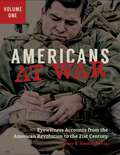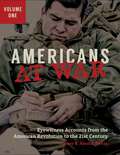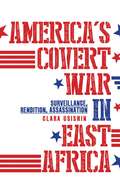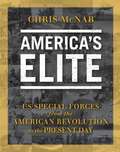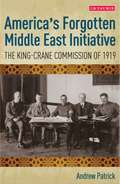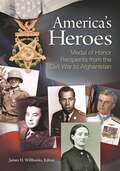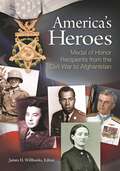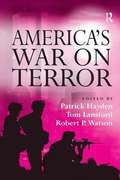- Table View
- List View
Americans at War [3 volumes]: Eyewitness Accounts from the American Revolution to the 21st Century [3 volumes]
by James R. ArnoldThis unprecedented compilation of eyewitness accounts records the thoughts and emotions of American soldiers spanning nearly 250 years of national history, from the American Revolution to the Afghanistan War.Understanding primary sources is essential to understanding warfare. This outstanding collection provides a diverse set of eyewitness accounts of Americans in combat throughout U.S. history. Offering riveting true stories, it includes accounts from participants in the American Revolution, the War of 1812, the Indian Wars, the Mexican-American War, the Civil War, the Spanish American War and Philippine Insurrection, World War I, World War II, the Korean War, the Vietnam War, The Persian Gulf War, the Afghanistan War, and the Iraq War.Most eyewitness accounts of war currently available to the public are those of writers who enjoy higher military rank. Americans at War addresses this imbalance between officers' accounts and enlisted men's accounts by invoking oral history archives. Contextual essays and timelines allow the reader to place the accounts in time and place, while the entries themselves allow the reader to experience the thoughts and emotions of Americans who engaged in combat.
Americans at War [3 volumes]: Eyewitness Accounts from the American Revolution to the 21st Century [3 volumes]
This unprecedented compilation of eyewitness accounts records the thoughts and emotions of American soldiers spanning nearly 250 years of national history, from the American Revolution to the Afghanistan War.Understanding primary sources is essential to understanding warfare. This outstanding collection provides a diverse set of eyewitness accounts of Americans in combat throughout U.S. history. Offering riveting true stories, it includes accounts from participants in the American Revolution, the War of 1812, the Indian Wars, the Mexican-American War, the Civil War, the Spanish American War and Philippine Insurrection, World War I, World War II, the Korean War, the Vietnam War, The Persian Gulf War, the Afghanistan War, and the Iraq War.Most eyewitness accounts of war currently available to the public are those of writers who enjoy higher military rank. Americans at War addresses this imbalance between officers' accounts and enlisted men's accounts by invoking oral history archives. Contextual essays and timelines allow the reader to place the accounts in time and place, while the entries themselves allow the reader to experience the thoughts and emotions of Americans who engaged in combat.
Americans, Germans, and War Crimes Justice: Law, Memory, and "The Good War"
by James J. WeingartnerThis ground-breaking comparative perspective on the subject of World War II war crimes and war justice focuses on American and German atrocities.Almost every war involves loss of life of both military personnel and civilians, but World War II involved an unprecedented example of state-directed and ideologically motivated genocide—the Holocaust. Beyond this horrific, premeditated war crime perpetrated on a massive scale, there were also isolated and spontaneous war crimes committed by both German and U.S. forces.The book is focused upon on two World War II atrocities—one committed by Germans and the other by Americans. The author carefully examines how the U.S. Army treated each crime, and gives accounts of the atrocities from both German and American perspectives. The two events are contextualized within multiple frameworks: the international law of war, the phenomenon of war criminality in World War II, and the German and American collective memories of World War II. Americans, Germans and War Crimes Justice: Law, Memory, and "The Good War" provides a fresh and comprehensive perspective on the complex and sensitive subject of World War II war crimes and justice.
Americans, Germans, and War Crimes Justice: Law, Memory, and "The Good War"
by James J. WeingartnerThis ground-breaking comparative perspective on the subject of World War II war crimes and war justice focuses on American and German atrocities.Almost every war involves loss of life of both military personnel and civilians, but World War II involved an unprecedented example of state-directed and ideologically motivated genocide—the Holocaust. Beyond this horrific, premeditated war crime perpetrated on a massive scale, there were also isolated and spontaneous war crimes committed by both German and U.S. forces.The book is focused upon on two World War II atrocities—one committed by Germans and the other by Americans. The author carefully examines how the U.S. Army treated each crime, and gives accounts of the atrocities from both German and American perspectives. The two events are contextualized within multiple frameworks: the international law of war, the phenomenon of war criminality in World War II, and the German and American collective memories of World War II. Americans, Germans and War Crimes Justice: Law, Memory, and "The Good War" provides a fresh and comprehensive perspective on the complex and sensitive subject of World War II war crimes and justice.
America's Arab Nationalists: From the Ottoman Revolution to the Rise of Hitler (Routledge Studies in Middle Eastern History)
by Aaron BermanAmerica’s Arab Nationalists focuses in on the relationship between Arab nationalists and Americans in the struggle for independence in an era when idealistic Americans could see the Arab nationalist struggle as an expression of their own values. In the first three decades of the twentieth century (from the 1908 Ottoman revolution to the rise of Hitler), important and influential Americans, including members of the small Arab-American community, intellectually, politically and financially participated in the construction of Arab nationalism. This book tells the story of a diverse group of people whose contributions are largely unknown to the American public. The role Americans played in the development of Arab nationalism has been largely unexplored by historians, making this an important and original contribution to scholarship. This volume is of great interest to students and academics in the field, though the narrative style is accessible to anoyone interested in Arab nationalism, the conflict between Zionists and Palestinians, and the United States’ relationship with the Arab world.
America's Arab Nationalists: From the Ottoman Revolution to the Rise of Hitler (Routledge Studies in Middle Eastern History)
by Aaron BermanAmerica’s Arab Nationalists focuses in on the relationship between Arab nationalists and Americans in the struggle for independence in an era when idealistic Americans could see the Arab nationalist struggle as an expression of their own values. In the first three decades of the twentieth century (from the 1908 Ottoman revolution to the rise of Hitler), important and influential Americans, including members of the small Arab-American community, intellectually, politically and financially participated in the construction of Arab nationalism. This book tells the story of a diverse group of people whose contributions are largely unknown to the American public. The role Americans played in the development of Arab nationalism has been largely unexplored by historians, making this an important and original contribution to scholarship. This volume is of great interest to students and academics in the field, though the narrative style is accessible to anoyone interested in Arab nationalism, the conflict between Zionists and Palestinians, and the United States’ relationship with the Arab world.
America's Cold War: The Politics of Insecurity, Second Edition
by Campbell Craig Fredrik Logevall“A creative, carefully researched, and incisive analysis of U.S. strategy during the long struggle against the Soviet Union.” —Stephen M. Walt, Foreign Policy “Craig and Logevall remind us that American foreign policy is decided as much by domestic pressures as external threats. America's Cold War is history at its provocative best.” —Mark Atwood Lawrence, author of The Vietnam War The Cold War dominated world affairs during the half century following World War II. America prevailed, but only after fifty years of grim international struggle, costly wars in Korea and Vietnam, trillions of dollars in military spending, and decades of nuclear showdowns. Was all of that necessary? In this new edition of their landmark history, Campbell Craig and Fredrik Logevall include recent scholarship on the Cold War, the Reagan and Bush administrations, and the collapse of the Soviet regime and expand their discussion of the nuclear revolution and origins of the Vietnam War to advance their original argument: that America’s response to a very real Soviet threat gave rise to a military and political system in Washington that is addicted to insecurity and the endless pursuit of enemies to destroy. America’s Cold War speaks vividly to debates about forever wars and threat inflation at the center of American politics today.
America's Covert War in East Africa: Surveillance, Rendition, Assassination (PDF)
by Clara UsiskinClara Usiskin has spent eight years investigating the 'War on Terror' and its effects in the East and Horn of Africa, documenting hundreds of cases of rendition, secret detention and targeted killings. As a result of her work exposing abuses carried out by regional governments and their international partners, Clara was deported from Kenya and Uganda and is currently persona non grata in both countries. Her book sets out the historical background to today's covert war, including the early Somali jihads and British repression in colonial Kenya, through to the 1998 US Embassy Bombings in Nairobi and Dar es Salaam, and President Clinton's early rendition programme. America's Covert War in East Africa then looks at the US Military's new Africa Command, with its emphasis on counterterrorism, alongside increasing use of targeted killings by security forces in the region, and continued renditions and secret detention. Finally, Usiskin investigates the shorter and longer term consequences of such intensive militarisation, and the proliferation of surveillance and other technologies of control in East Africa and its surrounding waters, focusing in particular on their impact on vulnerable ethnic and religious groups in a highly volatile region.
America’s Elite: US Special Forces from the American Revolution to the Present Day (General Military Ser.)
by Chris McNabAmerica's Elites takes the reader through some of the most dramatic special forces operations in US history, from sniping British commanders during the Revolutionary War to Riverine incursions in the Mekong Delta in Vietnam, and from demolition missions on D-Day to the SEAL assault on Osama bin Laden's compound in 2011. Training and selection procedures are explained in detail, and the book also describes some of the technologies that have separated regular soldiers from their Special Forces counterparts. Illustrated throughout with striking photography and artworks, America's Elites forms the most comprehensive and visually impressive single-volume guide to US Special Forces available.
America’s Elite: US Special Forces from the American Revolution to the Present Day
by Chris McNabAmerica's Elites takes the reader through some of the most dramatic special forces operations in US history, from sniping British commanders during the Revolutionary War to Riverine incursions in the Mekong Delta in Vietnam, and from demolition missions on D-Day to the SEAL assault on Osama bin Laden's compound in 2011. Training and selection procedures are explained in detail, and the book also describes some of the technologies that have separated regular soldiers from their Special Forces counterparts. Illustrated throughout with striking photography and artworks, America's Elites forms the most comprehensive and visually impressive single-volume guide to US Special Forces available.
America's Few: Marine Aces of the South Pacific
by Bill YenneAmerica's Few delves into the history of US Marine Corps aviation in World War II, following the feats of the Corps' top-scoring aces in the skies over Guadalcanal. Marine Corps aviation began in 1915, functioning as a self-contained expeditionary force. During the interwar period, the support of USMC amphibious operations became a key element of Marine aviation doctrine, and the small force gradually grew. But in December 1941 came the rude awakening. Within hours of Pearl Harbor, heroic Marine aviators were battling the Japanese over Wake Island. In the South Pacific, the aviators of the US Marine Corps came out of the shadows to establish themselves as an air force second to none. In the summer of 1942, when Allied airpower was cobbled together into a single unified entity – nicknamed 'the Cactus Air Force' – Marine Aviation dominated, and a Marine, Major General Roy Geiger, was its commander. Of the twelve Allied fighter squadrons that were part of the Cactus Air Force, eight were USMC squadrons. It was over Guadalcanal that Joe Foss emerged as a symbol of Marine aviation. As commander of VMF-121, he organized a group of fighter pilots that downed 72 enemy aircraft; Foss himself reached a score of 26. Pappy Boyington, meanwhile, had become a Marine aviator in 1935. Best known as the commander of VMF-214, he came into his own in late 1943 and eventually matched Foss's aerial victory score. Through the parallel stories of these two top-scoring fighter aces, as well as many other Marine aces, such as Ken Walsh (21 victories), Don Aldrich (20), John L. Smith (19), Wilbur Thomas (18.5), and Marion Carl (18.5), many of whom received the Medal of Honor, acclaimed aviation historian Bill Yenne examines the development of US Marine Corps aviation in the South Pacific.
America's Few: Marine Aces of the South Pacific
by Bill YenneAmerica's Few delves into the history of US Marine Corps aviation in World War II, following the feats of the Corps' top-scoring aces in the skies over Guadalcanal. Marine Corps aviation began in 1915, functioning as a self-contained expeditionary force. During the interwar period, the support of USMC amphibious operations became a key element of Marine aviation doctrine, and the small force gradually grew. But in December 1941 came the rude awakening. Within hours of Pearl Harbor, heroic Marine aviators were battling the Japanese over Wake Island. In the South Pacific, the aviators of the US Marine Corps came out of the shadows to establish themselves as an air force second to none. In the summer of 1942, when Allied airpower was cobbled together into a single unified entity – nicknamed 'the Cactus Air Force' – Marine Aviation dominated, and a Marine, Major General Roy Geiger, was its commander. Of the twelve Allied fighter squadrons that were part of the Cactus Air Force, eight were USMC squadrons. It was over Guadalcanal that Joe Foss emerged as a symbol of Marine aviation. As commander of VMF-121, he organized a group of fighter pilots that downed 72 enemy aircraft; Foss himself reached a score of 26. Pappy Boyington, meanwhile, had become a Marine aviator in 1935. Best known as the commander of VMF-214, he came into his own in late 1943 and eventually matched Foss's aerial victory score. Through the parallel stories of these two top-scoring fighter aces, as well as many other Marine aces, such as Ken Walsh (21 victories), Don Aldrich (20), John L. Smith (19), Wilbur Thomas (18.5), and Marion Carl (18.5), many of whom received the Medal of Honor, acclaimed aviation historian Bill Yenne examines the development of US Marine Corps aviation in the South Pacific.
America's Forgotten Middle East Initiative: The King-Crane Commission of 1919
by Andrew PatrickSent to the Middle East by Woodrow Wilson to ascertain the viability of self-determination in the disintegrating Ottoman Empire, the King-Crane Commission of 1919 was America's first foray into the region. The commission's controversial recommendations included the rejection of the idea of a Jewish state in Syria, US intervention in the Middle East and the end of French colonial aspirations. The Commission's recommendations proved inflammatory, even though its counsel on the question of the Palestinian mandate was eventually disregarded by Lloyd George and Georges Clemenceau in favour of their own national interests. In the ensuing years, the Commission's dismissal of claims by Zionist representatives like David Ben-Gurion on their 'right to Palestine' proved particularly divisive, with some historians labeling it prophetic and accurate, and others arguing that Commission members were biased and ill-informed. Here, in the first book-length analysis of the King-Crane report in nearly 50 years, Andrew Patrick chronicles the history of early US involvement in the region, and challenges extant interpretations of the turbulent relationship between the United States and the Middle East.
America's Forgotten Wars: The Counterrevolutionary Past and Lessons for the Future (Contributions in Military Studies)
by Sam C. Sarkesian“[This book provides] numerous brilliant and sound insights into the nature of low-level conflict. Sarkesian also perceptively describes the imperatives of the military mind set and armed forces structure necessary to help the US government achieve its national objectives in a turbulent world. Despite shortcomings, the book is a good and necessary work for those who want to know about the type of warfare that will engage our military forces for the rest of this century and beyond. Community college and above.”–Choice
America's Great Game: The CIA's Secret Arabists and the Shaping of the Modern Middle East
by Hugh WilfordThe Central Intelligence Agency's reputation in the Middle East today has been marred by waterboarding and drone strikes, yet in its earliest years the agency was actually the region's staunchest western ally. In America's Great Game, celebrated intelligence historian Hugh Wilford reveals how three colorful CIA operatives-Kermit and Archie Roosevelt, and maverick covert-ops expert Miles Copeland-attempted, futilely, to bring the U.S. and Middle East into harmony during the 1940s and '50s. Heirs to an American missionary tradition that taught them to treat Arabs and Muslims with respect and empathy, these CIA "Arabists” nevertheless behaved like political puppet-masters, orchestrating coup plots throughout the Middle East while seeking to sway public opinion in America against support for the new state of Israel. Their efforts, and ultimate failure, would doom U.S.-Middle Eastern relations for decades to come. Drawing on extensive new material, including declassified government records, private papers, and personal interviews, America's Great Game shows how three well-intentioned spies inadvertently ruptured relations between America and the Arab world.
America's Great Game: The CIA's Secret Arabists and the Shaping of the Modern Middle East
by Hugh WilfordFrom the 9/11 attacks to waterboarding to drone strikes, relations between the United States and the Middle East seem caught in a downward spiral. And all too often, the Central Intelligence Agency has made the situation worse. But this crisis was not a historical inevitability -- far from it. Indeed, the earliest generation of CIA operatives was actually the region's staunchest western ally. In America's Great Game, celebrated intelligence historian Hugh Wilford reveals the surprising history of the CIA's pro-Arab operations in the 1940s and 50s by tracing the work of the agency's three most influential -- and colorful -- officers in the Middle East. Kermit "Kim" Roosevelt was the grandson of Theodore Roosevelt and the first head of CIA covert action in the region; his cousin, Archie Roosevelt, was a Middle East scholar and chief of the Beirut station. The two Roosevelts joined combined forces with Miles Copeland, a maverick covert operations specialist who had joined the American intelligence establishment during World War II. With their deep knowledge of Middle Eastern affairs, the three men were heirs to an American missionary tradition that engaged Arabs and Muslims with respect and empathy. Yet they were also fascinated by imperial intrigue, and were eager to play a modern rematch of the "Great Game," the nineteenth-century struggle between Britain and Russia for control over central Asia. Despite their good intentions, these "Arabists" propped up authoritarian regimes, attempted secretly to sway public opinion in America against support for the new state of Israel, and staged coups that irrevocably destabilized the nations with which they empathized. Their efforts, and ultimate failure, would shape the course of U.S. -- Middle Eastern relations for decades to come. Based on a vast array of declassified government records, private papers, and personal interviews, America's Great Game tells the riveting story of the merry band of CIA officers whose spy games forever changed U.S. foreign policy.
America's Heroes: Medal of Honor Recipients from the Civil War to Afghanistan
by James H. WillbanksThis book features the stories of 200 heroic individuals awarded the Medal of Honor for their distinguished military service while fighting for their country, from the Civil War to the conflicts in Iraq and Afghanistan.America's Heroes: Medal of Honor Recipients from the Civil War to Afghanistan pays tribute to Americans who have demonstrated uncommon valor in the face of great danger. The Medal of Honor recipients featured in this book all acted heroically to earn this highly coveted award, many of them by risking—or sacrificing—their lives to save the lives of others. The stories of these individuals—chosen to reflect the wide diversity of ethnic and cultural backgrounds, branches of service, and conflicts of the recipients—will broaden readers' understanding and appreciation of the Medal of Honor and the distinguished Americans who have received it.In addition to the gripping stories of these heroic Americans, this unique encyclopedia includes an introduction that chronicles the evolution in the award's significance. The Medal of Honor has changed greatly over the last 150 years, not only in the design of the physical decoration itself, but also in terms of the qualifying criteria for the award's recipients.
America's Heroes: Medal of Honor Recipients from the Civil War to Afghanistan
by James H. WillbanksThis book features the stories of 200 heroic individuals awarded the Medal of Honor for their distinguished military service while fighting for their country, from the Civil War to the conflicts in Iraq and Afghanistan.America's Heroes: Medal of Honor Recipients from the Civil War to Afghanistan pays tribute to Americans who have demonstrated uncommon valor in the face of great danger. The Medal of Honor recipients featured in this book all acted heroically to earn this highly coveted award, many of them by risking—or sacrificing—their lives to save the lives of others. The stories of these individuals—chosen to reflect the wide diversity of ethnic and cultural backgrounds, branches of service, and conflicts of the recipients—will broaden readers' understanding and appreciation of the Medal of Honor and the distinguished Americans who have received it.In addition to the gripping stories of these heroic Americans, this unique encyclopedia includes an introduction that chronicles the evolution in the award's significance. The Medal of Honor has changed greatly over the last 150 years, not only in the design of the physical decoration itself, but also in terms of the qualifying criteria for the award's recipients.
America's Home Front Heroes: An Oral History of World War II (Non-ser.)
by Stacy EnyeartA new compendium of firsthand reminiscences of life on the American home front during World War II.America's Home Front Heroes: An Oral History of World War II brings together in one rich resource the voices of those whom history often leaves out—the ordinary men, women, and children caught up in an extraordinary time.America's Home Front Heroes is divided into four sections: A Time for Heightened Passion, A Time for Caution and Prejudice, A Time for Flag Waving, and A Time for War Plant Women. The 34 brief oral histories within these sections capture the full diversity of the United States during the war, with contributions coming from men, women, and children of all backgrounds, including Japanese Americans, conscientious objectors, African Americans, housewives, and journalists. A treasure trove for researchers and World War II enthusiasts, this remarkable volume offers members of "the greatest generation" an opportunity to relive their defining era. For those with no direct experience of the period, it's a chance to learn firsthand what it was like living in the United States at a pivotal moment in history.
America's Military Adversaries: From Colonial Times to the Present
by John C. FredriksenThis work chronicles the lives and accomplishments of over 200 enemies who have fought, plotted, spied on, and in some instances defeated U.S. forces over the past three centuries.Books on American military heroes abound. But this book is the first to focus on America's talented enemies—the generals, admirals, Indian chiefs and warriors, submarine captains, fighter pilots, and spies who opposed the United States with military force or other means. Often these military leaders were among the best minds of their times.For more than two centuries, the new nation's most constant military opponents were the Native Americans, led by such capable chiefs as American Horse and Little Wolf. Under D'Iberville, Canada's French colonialists became formidable foes, but they were soon surpassed by the rigorously disciplined redcoats of Great Britain under Howe and Cornwallis. Ironically, the most effective enemies in the history of the United States were not the leaders of foreign military forces—like Mexico's Santa Anna, Japan's Yamamoto, or Vietnam's Vo Nguyen Giap. They arose from among its own citizens during the Civil War, the bloodiest conflict in American history.
America’s Secret MiG Squadron: The Red Eagles of Project CONSTANT PEG
by Gaillard R. Peck Jr.America's Secret MiG Squadrons is the story of a group of incredibly brave military pioneers who put their lives on the line to establish a training program that would prepare the US Air Force for a potential Cold War battle with Soviet aircraft. As a F-4 Phantom II pilot in Vietnam, Col. Peck had been shocked by the technological abilities of Soviet-built aircraft, and at the poor level of training available to US pilots to aid them in their battles with Soviet MiGs in the skies over Vietnam. Working with the support of Gen Hoyt S. Vandenberg, Jr., and under conditions of extreme secrecy, the CONSTANT PEG program was launched with Peck as the original Red Eagle. This is the fascinating history of the men who trained to fly and maintain covertly obtained MiGs, for the first time providing an insider's perspective, personal anecdotes, and photographs, revealing how Peck battled bureaucracy and scepticism to ultimately establish the premier fighter pilot training center – the real Top Gun.
America’s Secret MiG Squadron: The Red Eagles of Project CONSTANT PEG
by Gaillard R. Peck Jr.America's Secret MiG Squadrons is the story of a group of incredibly brave military pioneers who put their lives on the line to establish a training program that would prepare the US Air Force for a potential Cold War battle with Soviet aircraft. As a F-4 Phantom II pilot in Vietnam, Col. Peck had been shocked by the technological abilities of Soviet-built aircraft, and at the poor level of training available to US pilots to aid them in their battles with Soviet MiGs in the skies over Vietnam. Working with the support of Gen Hoyt S. Vandenberg, Jr., and under conditions of extreme secrecy, the CONSTANT PEG program was launched with Peck as the original Red Eagle. This is the fascinating history of the men who trained to fly and maintain covertly obtained MiGs, for the first time providing an insider's perspective, personal anecdotes, and photographs, revealing how Peck battled bureaucracy and scepticism to ultimately establish the premier fighter pilot training center – the real Top Gun.
America's Vietnam War and Its French Connection (Routledge Advances in American History #5)
by Frank CainThat America was drawn into the Vietnam War by the French has been recognized, but rarely explored. This book analyzes the years from 1945 with the French military reconquest of Vietnam until 1963 with the execution of the French-endorsed dictator, Ngo Dinh Diem, demonstrating how the US should not have followed the French into Vietnam. It shows how the Korean War triggered the flow of American military hardware and finances to underpin France’s war against the Marxist-oriented Vietnam Republic led by Ho Chi Minh.
America's Vietnam War and Its French Connection (Routledge Advances in American History #5)
by Frank CainThat America was drawn into the Vietnam War by the French has been recognized, but rarely explored. This book analyzes the years from 1945 with the French military reconquest of Vietnam until 1963 with the execution of the French-endorsed dictator, Ngo Dinh Diem, demonstrating how the US should not have followed the French into Vietnam. It shows how the Korean War triggered the flow of American military hardware and finances to underpin France’s war against the Marxist-oriented Vietnam Republic led by Ho Chi Minh.
America's War on Terror (PDF)
by Patrick Hayden Tom Lansford Robert P. Watson9/11 has become more than a date. It has become a noun, an idea shaped and moulded by the media and the American political establishment and the rationale for the subsequent "War on Terror". But what are the real factors that have motivated the world's sole remaining superpower to engage in a permanent war declared on an often elusive and abstract enemy and risk the very relationships that have augmented that global status? While the tragic events of the 11th of September 2001 caused a sea-change in the perception and realities of American security interests and its ability to project a foreign policy agenda, simplistic views that the resulting "War on Terror" is merely "reactionary warfaring" no longer carry any credibility. To fully understand the direction of contemporary US foreign policy requires a detailed understanding of the complex political, historical and personal processes which influence America's new sense of itself and its view of the world. Written by a collection of leading analysts in the field, "America's War on Terror" sheds new light on the causes of the war on terror, the domestic and foreign policy implications and the forthcoming challenges for the United States and the global community.
